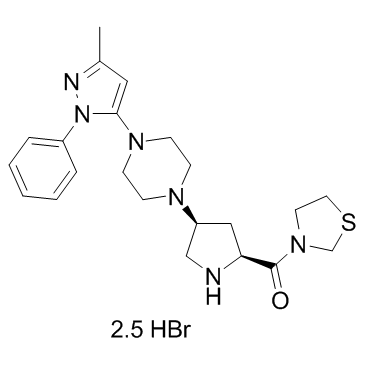| Description |
Teneligliptin hydrobromide is a potent chemotype prolylthiazolidine-based DPP-4 inhibitor, which competitively inhibits human plasma, rat plasma, and human recombinant DPP-4 in vitro, with IC50s of approximately 1 nM.
|
| Related Catalog |
|
| Target |
IC50: 1 nM (DPP4)[1]
|
| In Vitro |
Teneligliptin inhibits all these DPP-4 enzymes in a concentration-dependent manner. The IC50s of Teneligliptin for rhDPP-4, human plasma, and rat plasma are 0.889, 1.75, and 1.35 nM, respectively. A study of enzyme inhibition kinetics is conducted for Teneligliptin using Gly-Pro-MCA as the substrate and rhDPP-4 as the enzyme source. Plots based on the Michaelis-Menten equation reveals that Teneligliptin inhibits DPP-4 in a substrate-competitivemanner; the residual sum of squares for competitive and non-competitive models is 0.162 and 0.192, respectively. Ki, Km, and Vmax values are 0.406 nM, 24 μM, and 6.06 nmol/min, respectively. Teneligliptin inhibits the degradation of GLP-1(7-36)amide with an IC50 of 2.92 nM[1].
|
| In Vivo |
Oral administration of Teneligliptin in Wistar rats results in the inhibition of plasma DPP-4 with an ED50 of 0.41 mg/kg. Plasma DPP-4 inhibition is sustained even at 24 h after administration of Teneligliptin. An oral carbohydrate-loading test in Zucker fatty rats shows that Teneligliptin at ≥0.1 mg/kg increases the maximum increase in plasmaglucagon-like peptide-1 and insulin levels, and reduces glucose excursions. This effect is observed over 12 h after a dose of 1 mg/kg. An oral fat-loading test in Zucker fatty rats also shows that Teneligliptin at 1 mg/kg reduces triglyceride and free fatty acid excursions. In Zucker fatty rats, repeated administration of Teneligliptin for two weeks reduces glucose excursions in the oral carbohydrate-loading test and decreased the plasma levels of triglycerides and free fatty acids under non-fasting conditions. Oral administration of Teneligliptin inhibits plasma DPP-4 in rats in a dose-dependent manner. The ED50 value for Teneligliptin is calculated to be 0.41 mg/kg, while those for Sitagliptin and Vildagliptin, 27.3 and 12.8 mg/kg, respectively[1].Teneligliptin improves the histopathological appearance of the liver and decreases intrahepatic triglyceride levels in an NAFLD model mouse, which is associated with downregulation of hepatic lipogenesis-related genes due to AMPK activation[2].
|
| Kinase Assay |
DPP-4 inhibition assay is carried out using either 5 ng purified recombinant human DPP-4 (rhDPP-4), human plasma (20-fold diluted with assay buffer; phosphate-buffered saline (PBS) containing 0.003% Brij-35 solution), or rat plasma (10-fold diluted with assay buffer) Gly-Pro-MCA as a chromogenic substrate as described previously with slight modifications. DPP-4 inhibitors (Teneligliptin, Sitagliptin, and Vildagliptin) are diluted with assay buffer at several concentrations. Twenty microliters of inhibitor solution, 20 μL of the enzyme source, and 20 μL of Gly-Pro-MCA (final concentration, 25 μM) are mixed with 140 μL or 160 μL of assay buffer to initiate the enzyme reaction. After 20 min (rhDPP-4) or 1 h (plasma) at 37°C, the fluorescence intensity of 7-amino-4-methyl-coumarin (AMC) generated from Gly-Pro-MCA is measured using an automated microplate reader at 360 nm excitation and 465 nm emission. The fluorescence intensity of AMC corresponded to DPP-4 activity[1].
|
| Animal Admin |
Rats[1] Nine-week-old Wistar rats are randomly divided into 13 groups of eight animals each based on body weight (306.2-374.2 g) and plasma DPP-4 activity. Teneligliptin is orally administered to four groups (0.01, 0.1, 1 and 10 mg/2 mL/kg). Sitagliptin and vildagliptin is orally administered to each four groups (0.1, 1, 10 and 100 mg/kg). Vehicle (0.5% hydroxypropyl methylcellulose) is orally administered to one group. Blood samples are collected from the tail vein with heparinized capillary tubes at 0 h (pre dose) and 0.5, 1, 2, 3, 6, 9, 12, and 24 h (post dose) and centrifuged at 1800 g for 15 min at 4°C. Separated plasma is used for the measurement of DPP-4 activity. For dose-response curve using the maximum effect in each dose, the dose of the inhibitors which produce half of the maximum effect; ED50 are calculated. Mice[2] Monosodium glutamate (MSG) is administered into the neonatal ICR mice at birth as a single-dose subcutaneous injection (4 mg/g body weight). Among these mice, males are divided into two groups at 4 weeks of age: the MSG/HFD group (n=6, Group 1) and the MSG/HFD/Teneligliptin-treated group (n=6, Group 2). The mice in Group 2 are administered Teneligliptin (30 mg/kg per day) in the drinking water from 4 weeks of age. The treatment dose of Teneligliptin is determined according to the data from the animal experiments in the drug development process. Although the dose is relatively higher than that for humans in clinical practice, no notable adverse effect is observed in the treatment with the dose for the experimental animal in the process. Both groups are fed HFD from 4-14 weeks of age. At the termination of the experiment (14 weeks of age), all animals are sacrificed by CO2 asphyxiation to analyze hepatic histopathology.
|
| References |
[1]. Fukuda-Tsuru S, et al. A novel, potent, and long-lasting dipeptidyl peptidase-4 inhibitor, teneligliptin, improves postprandial hyperglycemia and dyslipidemia after single and repeated administrations. Eur J Pharmacol. 2012 Dec 5;696(1-3):194-202. [2]. Ideta T, et al. The Dipeptidyl Peptidase-4 Inhibitor Teneligliptin Attenuates Hepatic Lipogenesis via AMPK Activation in Non-Alcoholic Fatty Liver Disease Model Mice. Int J Mol Sci. 2015 Dec 8;16(12):29207-18.
|


